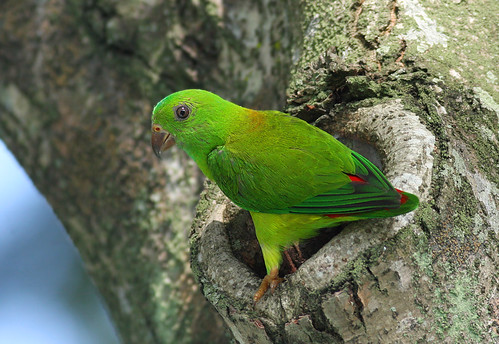
Long-tailed parakeets, Singapore Botanic Gardens;
(Photo by Lip Kee)
Parrots are commonly thought of as iconic birds of the tropics. Southeast Asia does have a very high number and diversity of parrot species, although most of its diversity is heavily concentrated in the myriad Indonesian islands that lie between the Greater Sundas and New Guinea. 12 parakeet species belonging to the genus Psittacula and 2 species of hanging parrot (Loriculus) are found in the general area covering the Indian subcontinent, Indochina, and nearby islands such as the Andaman and Nicobar Islands. In comparison, the Sundaland region itself, encompassing the Malay Peninsula, Sumatra, Borneo and Java, seems a little poor in parrot species, with a total of 5 species; 2 Psittacula parakeets, the endemic monotypic Psittinus, and 2 hanging parrots.
This post will give a brief introduction to the 3 native species of parrot in Singapore.
Long-tailed Parakeet (Psittacula longicauda)

Male long-tailed parakeet, Singapore Botanic Gardens;
(Photo by hiker1974)
The long-tailed parakeet is the most common native parrot, and can be found in many parts of Singapore, from forests to parks and secondary scrub, wherever there are sufficient tall trees to serve as nesting and roosting sites. This species has a relatively wide distribution, from the Andaman and Nicobar Islands in the Indian Ocean to the Malay Peninsula, Sumatra and Borneo. Populations also exist on many of the surrounding smaller islands. The female lacks the long tail feathers of the male, and the reddish coloration on the head is limited to the cheeks.

Female long-tailed parakeet, Singapore Botanic Gardens;
(Photo by Lip Kee)
Flocks can be spotted in the Changi Village area, where they now have to jostle for nest sites with 2 introduced parrot species, the red-breasted parakeet (Psittacula alexandri) and Tanimbar corella (Cacatua goffiniana). Similarly, the flock at the Botanic Gardens has to compete with red-breasted parakeets and rainbow lorikeets (Trichoglossus haematodus). In fact, it is likely that competition for resources with its introduced relative is leading to the native species being displaced; my personal observation is that the red-breasted parakeet appears to be more common than the long-tailed parakeet in the Changi and Pasir Ris area.
Blue-rumped Parrot (Psittinus cyanurus)

Male blue-rumped parrot, Taman Negara;
(Photo by John Wright)
This is a rare species restricted to the forests of the Central Nature Reserves. Elsewhere in its range, which includes the Malay Peninsula, Sumatra, and Borneo, this species is known to inhabit cultivated areas such as oil palm plantations. The most obvious difference between the sexes is that the male has a blue head while that of the female is brown.

Female blue-rumped parrot, Tawau;
(Photo by Wong Tsu Shi)
Blue-crowned Hanging Parrot (Loriculus galgulus)

Male blue-crowned hanging parrot, location unknown;
(Photo by Jonathan Cheah)
Like the blue-rumped parrot, this species has its stronghold in the Central Nature Reserves, although it can also be encountered in the Singapore Botanic Gardens, and occasionally elsewhere in suburban and urban Singapore, especially when there are trees flowering or fruiting.
The blue-crowned hanging parrot, like all other members of its genus, is often seen hanging from branches while feeding and roosting, hence the name. The easiest way to tell females apart from the males is that the females lack the dark blue feathers on the crown and the red throat patch.

Female blue-crowned hanging parrot, Bukit Panjang;
(Photo by kampang)
Its distribution is similar to that of the blue-rumped parrot, being found on the Malay Peninsula, Sumatra and Borneo, and it has also been introduced to the Jakarta area on Java. This is a species that has been heavily exploited for the pet trade.
These 3 native species of parrot have been joined in recent decades by a wide variety of newcomers. Having escaped or been released from captivity, many of these other parrot species have begun to establish themselves in Singapore, and are now breeding. Others have been known to occur locally for several years, but breeding has yet to be recorded; these populations are being sustained by fresh escapees or releases. Many more have been sighted as lone individuals, and in the absence of breeding partners, are unlikely to become a long-term component of Singapore's avifauna. But further discussion on these non-native parrots is best left for another time.